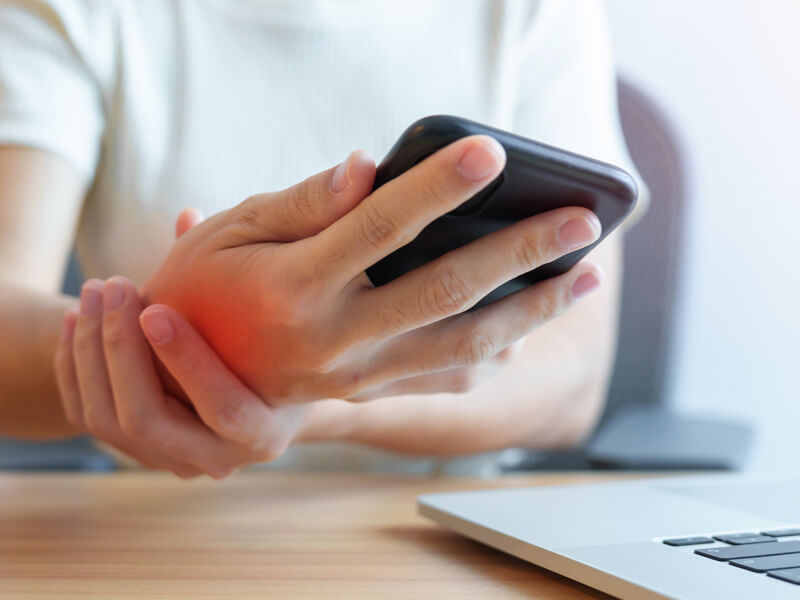
Do you have pain when you move your fingers or wrist? Finger and wrist pain can be caused by tendonitis.
Tenosynovitis is said to be more common in women and people who overuse their fingers and wrists on a regular basis. In the era of Reiwa, most people use smartphones, but have you ever experienced pain in your fingers after using it for a long time?
In this article, we will explain how tendonitis occurs, how to prevent it, and the types of tendonitis.
table of contents
What is Tenosynovitis
Muscles are connected to bones by tendons. A tissue called a tendon sheath protects the tendon from friction.
Tenosynovitis is a condition in which the tendon sheath that envelops the tendon becomes inflamed, causing pain during finger and wrist movements.
Tenosynovitis tends to appear mainly in the wrists and fingers, and is said to be caused by overuse.
If the tendonitis is mild, the symptoms can be improved by applying ointment or lightening the burden on the hand. However, if it recurs repeatedly or if the pain is left untreated, the symptoms may worsen, leading to a condition called spring finger.
In recent years, there are many people who have pain in their thumbs due to the operation of smartphones.
Tenosynovitis also includes a condition called trigger finger or de Quervain's disease. Let's talk about each disease.
spring finger
If it becomes a spring finger, it will get caught when the finger is extended from a bent state. A state in which it becomes difficult to extend a finger by one's own strength alone, or a state in which the finger suddenly extends as if it were snapping, is called a spring finger.
It is thought that the spring finger does not become sudden, but follows the course as follows.
Elapsed time until spring finger
- Overuse of the fingers can cause inflammation of tendons and tendon sheaths.
- Symptoms are temporarily relieved, but relapses occur repeatedly.
- The inflamed area gradually thickens and the gap between the tendon and the tendon sheath becomes smaller.
- When the finger is moved, it becomes caught, resulting in a spring finger.
Trigger finger thus occurs due to binding of the tendon and tendon sheath.
de Quervain's disease
De Quervain's disease is tendonitis around the wrist. Pain occurs mainly in the tendons used to extend the thumb or spread the hand out wide.
In recent years, the number of people who suffer from de Quervain's disease due to smartphone operation is increasing.
As a cause of pain, it is the same as when other fingers become tenosynovitis.
Overuse of the thumb can lead to inflammation of the thumb extensor tendons and tendon sheaths, resulting in pain during wrist and thumb movements.
Characteristics of people prone to tendonitis
People who are prone to tendonitis are those who overuse their fingers and wrists. People who write a lot of letters and pictures, people who use computers a lot, and people who use rackets in sports should also be careful of tendonitis.
Also, it is said that women are more prone to tendonitis due to hormones. A decrease in estrogen makes it easier to injure tendons.
for that reason,Menopause, pregnancy, and those who have given birth are said to need special attention.
In addition, people with diseases such as diabetes and rheumatoid arthritis are also prone to tendonitis. This is because these diseases are prone to inflammation and are difficult to reduce.
To prevent tendonitis
People who work on a computer for a long time need to reduce the burden on their wrists and fingers by adjusting the angle of the keyboard, adjusting the desk and chair, and using cushions.
In sports, form can cause tendonitis. Wearing a form that doesn't strain your wrists may help prevent tendonitis.
Diabetes and rheumatoid arthritis can also cause tendonitis, so it is necessary to firmly control these diseases. In order to stabilize your symptoms, make sure that you do not forget to review your lifestyle or forget to take your medicine.
If you think you have tendonitis
First, keep the affected area quiet. Avoid using the painful area and wait for the inflammation to subside.
If the painful area is swollen or has a fever, icing it with ice.
Do icing for about 20 minutes and take a break. If the heat remains after about 2 hours, apply icing again.
Treatment of tendonitis
First of all, you need to rest, but you may also use ointment to reduce inflammation in the affected area.
It is also effective to stretch the muscles that are burdened.
In the treatment of trigger finger, there are cases in which an injection is given to a place where slipping is difficult, and in which the tendon sheath is partly opened by surgery.
Please consult with the person in charge of the medical institution about the treatment policy.
summary
In this article, we have explained the pathology and characteristics of tendonitis.
Tenosynovitis is mainly caused by overuse of the fingers and wrists, but it is possible to prevent it by taking care of the environment and stretching so as not to put too much strain on it.
Rest and icing will also be needed if tendonitis is suspected. If symptoms persist, it is necessary to consult a medical institution as soon as possible.
Excessive use of smartphones is one of the causes of tendonitis, so try to use them while resting.
References
・Misako Nishimori et al.: Pathophysiological features of flexor tendonitis (spring finger) seen from joint ultrasound images, Ultrasound examination technology, Vol.38 (2013) No.1, p13-20
https://www.jstage.jst.go.jp/article/jss/38/1/38_13/_pdf/-char/ja
・Kosuke Uehara: Stretching for constrictive flexor tendonitis, Orthopedic and Disaster Surgery Vol.65 No.4 (April 2022), p451-455
https://webview.isho.jp/journal/detail/pdf/10.18888/se.0000002100
・Shuhei Kurihara et al.: Research on thumb operation characteristics of smartphone users, 2017Annual Vol.55 No.5PM-Abstract p476
https://www.jstage.jst.go.jp/article/jsmbe/55Annual/5PM-Abstract/55Annual_476/_pdf/-char/ja
Supervision: Dr. Yasushi Tsuda
